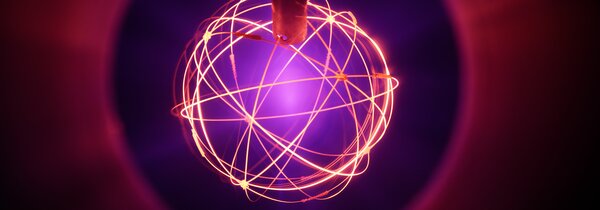Fusor

The Fusor: a long known approach
In the mid-1950's, P. T. Farnsworth came up with the idea of using a spherical diode as a fusion machine. This device was called the "Fusor", and would cause ions of fusion fuel to speed to the center of the machine. As they converged on the central focus region, their density would increase rapidly, making collisions in the center (and thus the chance of a fusion reaction) more likely.
The TU/e fusor: a modern variant

The fusor that we have built in the Fusion group is still based on this basic principle, but it's a modern variant - one of the most advanced fusor devices in the world. The fusor that is part of our PlasmaLab does not use a diode anymore, but it uses a very open spherical grid to accelerate the ions (a so-called Hirsch-Farnsworth type of fusor).
This inner grid can be charged negatively up to 100 kV, with respect to the outer one. It thereby achieves considerable ion recirculation: ions that do not collide decelerate out the other side, stop, and accelerate back to the center for another try, conserving energy.
When Deuterium ions are accelerated sufficiently, by putting a high enough voltage on the grid, they have a chance of causing a fusion reaction. Although not very efficient, this form of electrostatic ion generator is a simple way to study the physics principles behind the Fusor. The Fusor can be equiped with several diagnostic systems, ranging from active Langmuir probes to passive spectroscopy, to study the processes inside.
Making the fusor an efficient source of neutrons
Although this type of fusion device can be demonstrated not to be efficient enough for its possible use as an energy source, there are many interesting phenomena that can be studied, and the fusor has al been demonstrated as a viable neutron source. One of our goals is to find the best conditions for making it an efficient source of neutrons: you can read more on our research that is centered around the fusor here.
